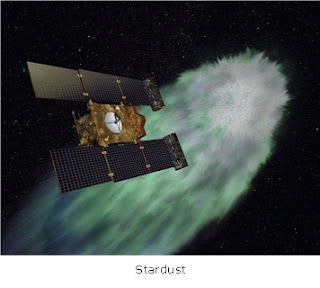Stardust was a 390-kilogram robotic space probe launched by NASA on 7 February 1999.
Its primary mission was to collect dust samples from the coma of comet Wild 2, as well as samples of cosmic dust, and return these to Earth for analysis. It was the first sample return mission of its kind. En route to comet Wild 2, the craft also flew by and studied the asteroid 5535 Annefrank. The primary mission was successfully completed on 15 January 2006, when the sample return capsule returned to Earth.
A mission extension codenamed NExT culminated in February 2011 with Stardust intercepting comet Tempel 1, a small Solar System body previously visited by Deep Impact in 2005. Stardust ceased operations in March 2011.
On 14 August 2014, scientists announced the identification of possible interstellar dust particles from the Stardust capsule returned to Earth in 2006.
Beginning in the 1980s, scientists began seeking a dedicated mission to study a comet. During the early 1990s, several missions to study comet Halley became the first successful missions to return close-up data. However, the US cometary mission, Comet Rendezvous Asteroid Flyby, was canceled for budgetary reasons. In the mid-1990s, further support was given to a cheaper, Discovery-class mission that would study comet Wild 2 in 2004.
Stardust was competitively selected in the fall of 1995 as a NASA Discovery Program mission of low-cost with highly focused science goals. Construction of Stardust began in 1996, and was subject to the maximum contamination restriction, level 5 planetary protection. However, the risk of interplanetary contamination by alien life was judged low, as particle impacts at over 1,000 miles per hour, even into aerogel, were believed to be terminal for any known microorganism.
Comet Wild 2 was selected as the primary target of the mission for the rare chance to observe a long-period comet that has ventured close to the Sun.
The comet has since become a short period comet after an event in 1974, where the orbit of Wild 2 was affected by the gravitational pull of Jupiter, moving the orbit inward, closer to the Sun. In planning the mission, it was expected that most of the original material from which the comet formed would still be preserved.
More information: NASA
The primary science objectives of the mission included:
-Providing a flyby of a comet of interest (Wild 2) at a sufficiently low velocity, less than 6.5 km/s, such that non-destructive capture of comet dust is possible using an aerogel collector.
-Facilitating the intercept of significant numbers of interstellar dust particles using the same collection medium, also at as low a velocity as possible.
-Returning as many high-resolution images of the comet coma and nucleus as possible, subject to the cost constraints of the mission.
The spacecraft was designed, built and operated by Lockheed Martin Astronautics as a Discovery-class mission in Denver, Colorado. JPL provided mission management for the NASA division for mission operations. The principal investigator of the mission was Dr. Donald Brownlee from the University of Washington.
Stardust was launched at 21:04:15 UTC on 7 February 1999, by the National Aeronautics and Space Administration from Space Launch Complex 17A at the Cape Canaveral Air Force Station in Florida, aboard a Delta II 7426 launch vehicle.
The complete burn sequence lasted for 27 minutes bringing the spacecraft into a heliocentric orbit that would bring the spacecraft around the Sun and past Earth for a gravity assist maneuver in 2001, to reach asteroid 5535 Annefrank in 2002 and comet Wild 2 in 2004 at a low flyby velocity of 6.1 km/s.
In 2004, the spacecraft performed a course correction that would allow it to pass by Earth a second time in 2006, to release the Sample Return Capsule for a landing in Utah in the Bonneville Salt Flats.
During the second encounter with Earth, the Sample Return Capsule was released on Jan 15, 2006. Immediately afterwards, Stardust was put into a divert maneuver to avoid entering the atmosphere alongside the capsule. Under twenty kilograms of propellant remained onboard after the maneuver.
On 29 January 2006, the spacecraft was put in hibernation mode with only the solar panels and receiver active, in a 3-year heliocentric orbit that would return it to Earth vicinity on 14 January 2009.
A subsequent mission extension was approved on 3 July 2007, to bring the spacecraft back to full operation for a flyby of comet Tempel 1 in 2011. The mission extension was the first to revisit a small Solar System body and used the remaining propellant, signaling the end of the useful life for the spacecraft.
At 19:21:28 UTC, on 2 January 2004, Stardust encountered Comet Wild 2 on the sunward side with a relative velocity of 6.1 km/s at a distance of 237 km.
The original encounter distance was planned to be 150 km, but this was changed after a safety review board increased the closest approach distance to minimize the potential for catastrophic dust collisions.
The relative velocity between the comet and the spacecraft was such that the comet actually overtook the spacecraft from behind as they traveled around the Sun. During the encounter, the spacecraft was on the Sunlit side of the nucleus, approaching at a solar phase angle of 70 degrees, reaching a minimum angle of 3 degrees near closest approach and departing at a phase angle of 110 degrees. The AutoNav software was used during the flyby.
During the flyby the spacecraft deployed the Sample Collection plate to collect dust grain samples from the coma, and took detailed pictures of the icy nucleus.
More information: SPACE
The iron in the hemoglobin molecules in the blood
in your right hand came from a star
that blew up 8 billion years ago.
The iron in your left hand came from another star.
Jill Tarter

No comments:
Post a Comment